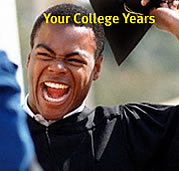


“There is no simpler, more direct, or more important determinant of human welfare today than educational attainment....[And] today, students born into families in the top income quartile have never had it so good. But students from families in the bottom quartile have never had it so bad.”– Thomas Mortenson, “Poverty, Race, and the Failure of Public Policy: The Crisis of Access in Higher Education,” Academe “I won’t be defined by a statistic, like ‘how people who grow up in this area are more likely to
turn out.’ |
 |
- Students in poor neighborhoods share the same college hopes as wealthier students. But they start out without the advantages, and so do their schools. Students who are Black or Hispanic have a 50 percent chance of finishing high school with a diploma. Native American youth have a 30 percent chance. By comparison, graduation rates for Whites and Asians are 75 and 77 percent.
- Only 20 percent of college-age Hispanic students and 31 percent of college-age Black students are enrolled in college. For Whites and Asians, the numbers are 41 and 60 percent.
- Only 6 percent of low-income students earn a bachelors degree, compared to 40 percent of high-income students. On average, low-income students also take longer to achieve their degree.
- The percentage of Blacks ages 25 to 35 with four-year college degrees more than doubled between 1970 and 2000, going from 6.5 percent to 15 percent.
- In 2000, 22 percent of 18- to 24-year-old Hispanics were enrolled in college, up from 16 percent in 1980. Between 1980 and 1990, the number of bachelors degrees awarded to Hispanics rose by 68 percent. During the 1990s, it rose by 105 percent, faster than for any other racial/ethnic group.
- The percentage of low-income high school graduates, ages 16-24, enrolled in college grew from 23 percent in 1972 to 44 percent in 1996.
- More than three-quarters of students who earn an A or A-plus grade average in high school complete college, compared to one-fifth of students with a C average in high school.
- Over 60 percent of students who have taken two or more Advanced Placement (AP) courses in high school graduate from college in four years or less, compared with 29 percent of students who have taken no AP classes.
- Seventy-five percent of students who take pre-calculus in high school go on to earn a bachelors degree, compared to 7 percent who stop math after Algebra 1.
- In 2002, average tuition and fees came to $4,000 at a public four-year college or university and $18,000 at a private institution. These figures do not include the additional costs for room and board, books and supplies, transportation, and other personal expenses.
- In 1986, the average federal need-based Pell Grant covered 98 percent of tuition at a public four-year school. Today these grants cover only 57 percent of state-school tuition.
- Despite soaring tuition costs, in 1999-2000, half of all undergraduates who attended a college or university participating in federal student aid programs failed to apply for financial aid. In 2005, there were over 1.3 million scholarships were available, worth over $3 billion.
- Over a lifetime, a college graduate can expect to earn $1 million more than a high school graduate.
- On average, college graduates have lower rates of unemployment than high school graduates.
- College graduates have more jobs to choose from.
- Just one year of college can increase lifetime earnings 15 percent.
- College gets you out of your neighborhood and into a bigger world. It can open doors you never imagined.
- People see you as a leader when you are the first in your family to go to college.
- When you have a college education, you make better decisions as a consumer.
- People who go to college live longer.
This website is brought to you by What Kids Can Do with the generous support of the Lumina Foundation for Education. What Kids Can Do, Inc. |